Virtually all living things react to significant temperature changes. In their reaction, some become resistant to extreme temperatures, while others try to avoid such extreme temperatures altogether.
Like most living things, plants react to extreme temperatures, especially frost. Frost typically happens at temperatures below 32°F. But while some plants respond to it with tolerance, the more sensitive ones lose their leaves, become less productive, shrink, or die.
Depending on various factors, plants can either be frost-tolerant or frost-sensitive. But for us in this article, we focus on frost-sensitive plants. We discuss how frost affects them, how to protect them from frost, and much more.
Table of Contents
Frost Sensitive Fruits and Vegetables
Tomato

Tomato plants are frost-sensitive. While they might be able to resist a light freeze at temperatures as low as 28 to 30 °F, frost does some severe damages to tomatoes.
Interestingly, while light freeze at 30 °F may not harm tomatoes. Frost at around 40 °F will. The difference? Moisture.
Frost typically involves moisture, while light freeze involves little or no moistness.
Generally, when frost occurs and tomato plants or fruits freeze, they die. If the temperature stays slightly above frost temperature, the plant’s growth may only be stunted.
Actively growing vegetative parts and new buds are particularly more sensitive than other parts to low temperatures. Therefore, in cases where the frost is brief, fully grown tomato plants may survive the cold. Of course, if such plants have fresh growth, those parts are unlikely to survive.
How to Protect Your Tomato From Frost
- The weather forecast will hint to you of an impending frost, so pay attention to it.
- When a frost is imminent, the best way to protect your tomato plant is to get coverings for them. Such coverings could be tunnel row covers, plant covers, sheets, lightweight blankets, clear plastic, or water barriers.
- If the season is over, harvest the mature fruits, even the green ones. You may leave the immature ones as they will never become ripe.
- So far, it appears there are no frost-resistant tomato cultivars. So, if you live in a region where the growing season is short, opt for a fast-growing cultivar.
Okra
Okra needs warm temperatures – anywhere from 6 °F and above – to thrive. So, in cold temperatures, the seeds will not even germinate. If the seeds germinate before a frost comes, the budding okra plant will be killed when frost arrives.
Now, there is a chance that okra plants may survive a brief, light frost. But this is not certain, so do not take the risk.
How to Protect Your Okra From Frost
The best way to protect okra from frost is to plant it before or after frost. To achieve this, you can:
- Plant your okra at least 90 days before the first fall frost date.
- Alternatively, you may start your okra in a pot indoors 3-4 weeks before the last spring frost date. While indoors, cover the plant with a grow tunnel or a cold frame. Then when the weather warms up, transfer the okra into your garden.
Pumpkin

Pumpkins can recover after a light frost – brief frost or frost that disappears when the sun shines. The vines may die off after a light frost, but the fruits can recover. However, when there is a hard frost, both the vines and pumpkins will die.
You should harvest your mature pumpkins before a hard frost. As for the immature ones, they will not ripen once they experience a hard frost.
How to Protect Your Pumpkin From Frost
- You can protect your pumpkins from frost using newspapers, row covers, frost blankets, cardboards, and old blankets.
Eggplant
Eggplants are frost-sensitive; at around 31 to 33°F, they die. With eggplants, as the temperature starts going below 50°F, growth slows. Then when the cold gets pretty intense, they begin to die off.
How to Protect Your Eggplant From Frost
- Coverings can help protect eggplant from frost. One such method involves punching garden stakes in the soil around the eggplants then placing bubble wraps on the stakes.
Beans

Generally, beans are frost-sensitive. They prefer temperatures around 70 to 80°F for optimal growth. But once the temperature drops below 60°F, their growth slows. Then around 32°F or below, they start to die.
Temperatures slightly higher than 32°F may not kill your beans outright. But they sure will reduce your yield.
How to Protect Your Beans From Frost
- You might be able to protect your beans by covering the plants with cloches.
- If they are planted in pots, you may bring them indoors then transfer them outdoors when it gets warm again.
- For people living in colder regions, you may opt for the winter field beans cultivar. They are relatively more cold-hardy than most other bean cultivars. But even at that, they may succumb to frost at around 10 to 15°F.
Frost Sensitive Root Vegetables
Potato

Potatoes might be able to withstand temperatures around 28 to 32°F. But anything below 28°F is sure to kill the part of the plant aboveground.
If your potato is protected correctly, it may survive hard frost (temperatures below 28°F).
Light frost (28 to 32°F) typically does little or no damage to potato plants. If there is minimal damage, you will notice symptoms like black edges on the leaves.
With hard frost, you will notice symptoms like death or wilting of shoots and leaves. Luckily, the roots may recover and regrow new shoots in around 10-14 days.
The plant may also produce tubers. But it may take longer than usual for this to happen, and the yield would most likely be less than expected.
How to Protect Your Potato From Frost
- Potato tubers can survive frost if they remain underground. So, you can leave them underground and harvest after the shoots die back.
- Plant covers like cloche and row covers can help keep your potato plants relatively warm in frost.
- You may also build a greenhouse over your potato plants; it is typically warmer inside greenhouses.
- You may also hill your potatoes plants to prevent them from frost. Hilling is particularly helpful to young plants as it can protect them against late spring frost. Besides that, hilling can help minimize sun exposure and prevent the formation of toxic, green skin.
Sweet Potato
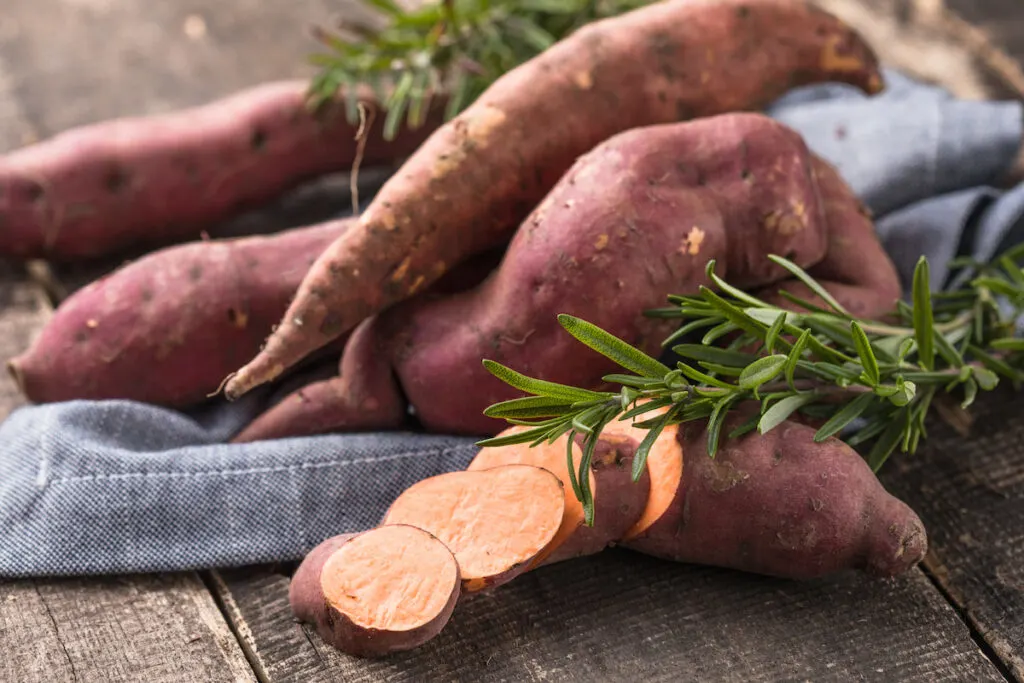
While sweet potato tubers might be insulated underground, their vines are not. Unfortunately, when exposed to frost, their vines burn black from frostbite and die off.
If you have not harvested your sweet potato tubers when the vines die from frostbite, cut the dead vines off and collect the tubers ASAP.
Even with the insulation the soil provides for the tubers, sweet potatoes are not immune to cold. At around 45°F, sweet potato tubers may start showing signs of injury. When injured, they may become black on the inside and outside, and their surface may sink.
How to Protect Your Sweet Potato From Frost
- You may protect your sweet potato from frost by covering it with suspended plastic sheeting placed on bamboo stakes. Before covering the plantation with the sheeting, however, water the vines thoroughly. Ensure you anchor the covering to keep the cold air from throwing it away.
- If the south-facing wall in your garden still receives sunlight and your garden is protected against wind, you may plant the sweet potato vine against the wall.
Frost Sensitive Grains
Amaranth
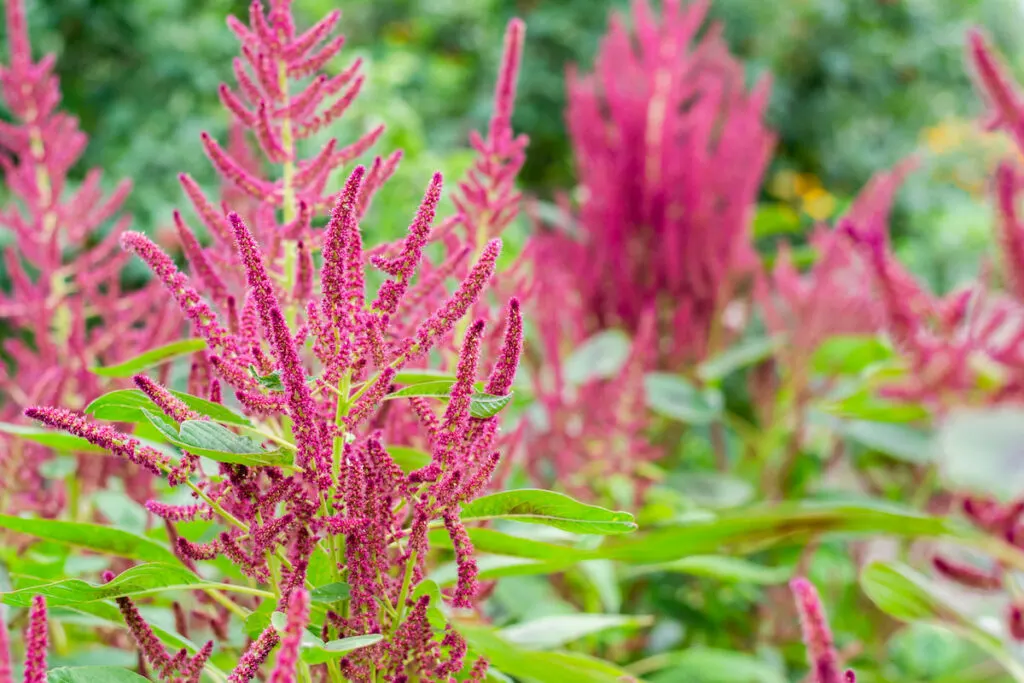
Amaranth cannot survive frost.
For one, the seeds will not germinate even if there is a thin layer of frost above the soil. Then, the mature plants die back when the temperature drops drastically.
How to Protect Your Amaranth From Frost
- Wait until after the last spring frost date to plant amaranth seeds. Once the soil is warm, plant the seeds.
Corn

Temperatures around 32°F can kill corn within a few hours. But if the temperature falls to around 28°F or below, corn will die within minutes.
At temperatures slightly above 32°F, corn may not die from frost. But they will suffer severe damages. Such damages may not manifest until after 24-48 hours. Some symptoms of frost damage in corn include brown discoloration of the leaves and water-soaked leaves.
Typically, frost damage to corn only affects the parts above ground. And if the plant is in an early development stage, it may recover.
You may not be able to differentiate dead corn tissue from living readily. Sometimes, it takes up to 7 days to notice the differences.
How to Protect Your Corn From Frost
- You can cover your corns to protect them from frost. You may use row covers, garden quilts, or frost blankets since they offer some breathability. For temperatures lower than 24°F, thicker row covers would do. But for temperatures around 28°F or higher, thinner row covers should suffice.
- Corn that has not emerged from the soil is usually safe from the harshness of frost. And it typically takes corn 7 to 10 days to germinate. So, you could plant your corn at least 10 days before the last spring frost date.
Frost Sensitive Shrubs
Azalea

In general, a sharp drop in temperature may affect azaleas and injure them. But some plants can survive a gradual fall in temperature.
Azalea plants might be able to survive frost with or without protection. But even if they do endure, their flowers will get ruined. So, azaleas in bloom when there is frost will be selectively sensitive.
Besides blooming azaleas, young azalea plants are also frost-sensitive. They suffer some severe damage when exposed to sub-25°F temperatures. You may see signs like dried leaves and split bark in affected plants.
How to Protect Your Azalea From Frost
- Covering your azalea with breathable materials is sure to help minimize the effect of frost. You can use covers like burlap and old bedsheets over the shrub. Drive stakes in the ground, then place the covering on the shrubs while ensuring it does not touch the foliage. Things would be easier for you if you installed the stakes before the ground freezes.
Rhododendron
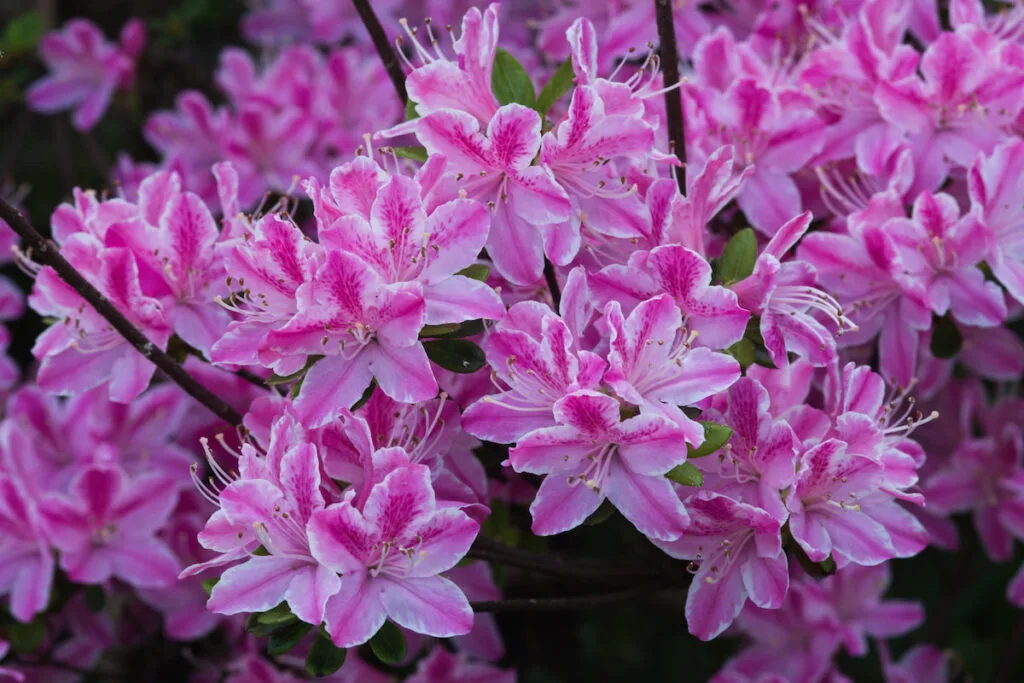
Many rhododendron varieties are tolerant to frost. But most new growth of these plants will die off in cold temperatures. Besides that, while rhododendron shrubs may survive temperatures as low as -35 °F, their flowers and leaves may not survive.
How to Protect Your Rhododendron From Frost
- You can cover rhododendrons with burlap or similar protective materials to shield them from frost or extreme cold.
- You should also install windbreaks to protect the plants from drying winds.
Pineapple
Once the temperature goes below 60°F, the growth rate of pineapples will begin to drop. Then at temperatures below 28°F, they may get injured or die.
Some signs of frost damage in pineapples include white or red specks on the upper leaf surfaces, rotten fruit pulp, and a scorched appearance.
How to Protect Your Pineapple From Frost
- You can shield your pineapple from frost by insulating it with mulch or a blanket.
- If the pineapple is in a pot or container, you can move it inside to protect it from frost.
Frost Sensitive Trees
Lemon Trees
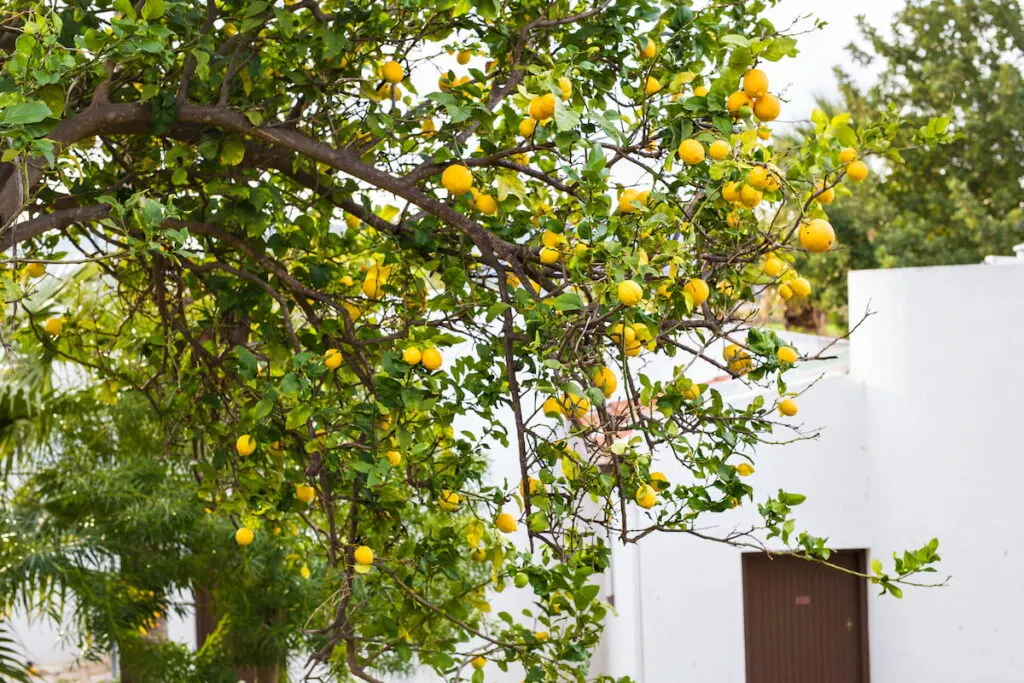
Healthy mature lemon trees may survive frost but not without some damage. Winter temperatures around 29°F or lower hurt lemon trees within minutes. Some symptoms of frost damage in lemon trees include dying flowers, dying immature fruits, dropping leaves, and bursting fruits.
If the frost persists or the temperature falls to around 20°F, the bark may also become injured.
How to Protect Your Lemon Trees From Frost
- You can prevent frost damage in lemon trees by moistening the soil routinely. As soil water evaporates, it will generate some heat to keep the tree warm.
- You can also wrap your lemon tree with some warm material like old bedsheets, cardboards, and blankets to shield it from frost.
- You could also install a string of light bulbs around the tree to generate warmth. One downside to this method is the cost of electricity.
- You can also move your lemon tree indoors. While indoors, ensure the tree gets as much sunlight as possible. Also, make sure you place it in a room with a temperature between 55 and 70°F.
Mango Trees
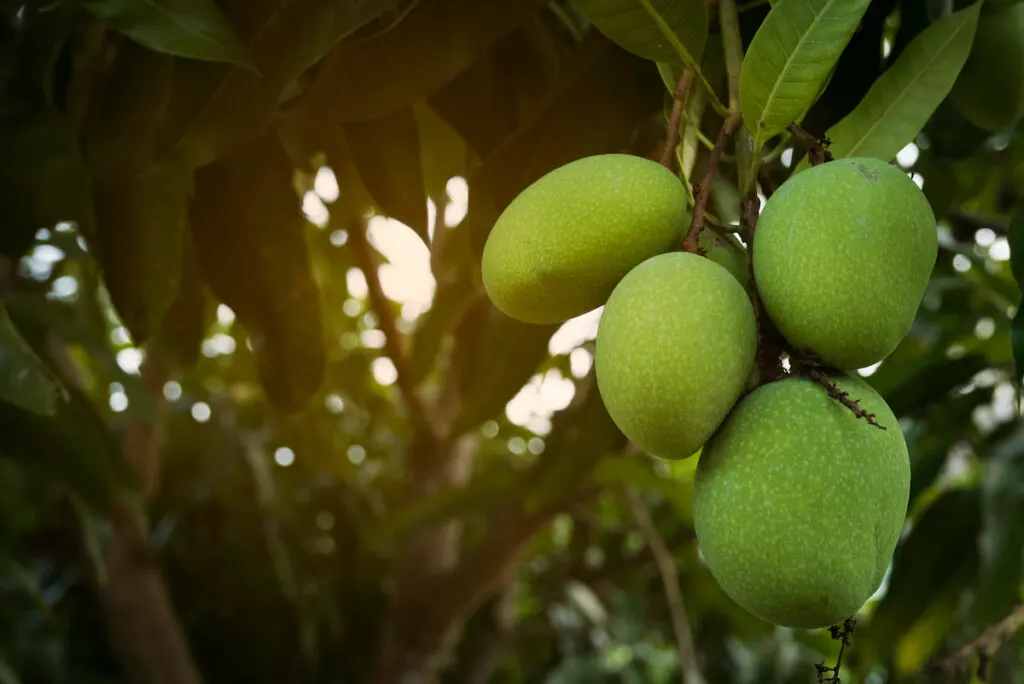
Generally, mature mango trees can tolerate frost better than younger trees. At around 30°F, younger mango trees suffer acute damage, and in some cases, they die.
Mature mango trees would do fine at 25°F for a few hours. But even at that, you should not leave them unprotected. Light frost may still damage their foliage and smaller branches.
How to Protect Your Mango Trees From Frost
- Swathe a frost blanket over your mango trees on cold evenings and nights to screen them from the freeze.
- You may also string some light bulbs around the trees for warmth.
- Creating a soil bank around the base of your mango trees can also help with warmth. Just ensure you loosen the soil bank when the weather becomes warmer.
Banana Tree
Banana trees are not very lucky in winter. At 32°F or below, bananas will lose their foliage to frost. Then if the temperature falls a little lower, the whole plant will die.
In some instances, the roots may survive temperatures as low as 22°F and remain functional. But anything below this, and it may be the end.
How to Protect Your Banana Trees From Frost
- Well, you can treat your banana trees like an annual plant, so you never have to worry about frost. Just plant it in spring, harvest in summer, and let it die off in fall or winter when it becomes frosty. Then repeat the process.
- Alternatively, you may transfer your banana tree indoors to save them from frost. But you should do this a few weeks before the temperatures become too cold.
- If the tree is too big to be transferred indoors, cut it to around 6 inches. Then cover it up with multiple layers of mulch.
Frost Sensitive Perennials
Cannas
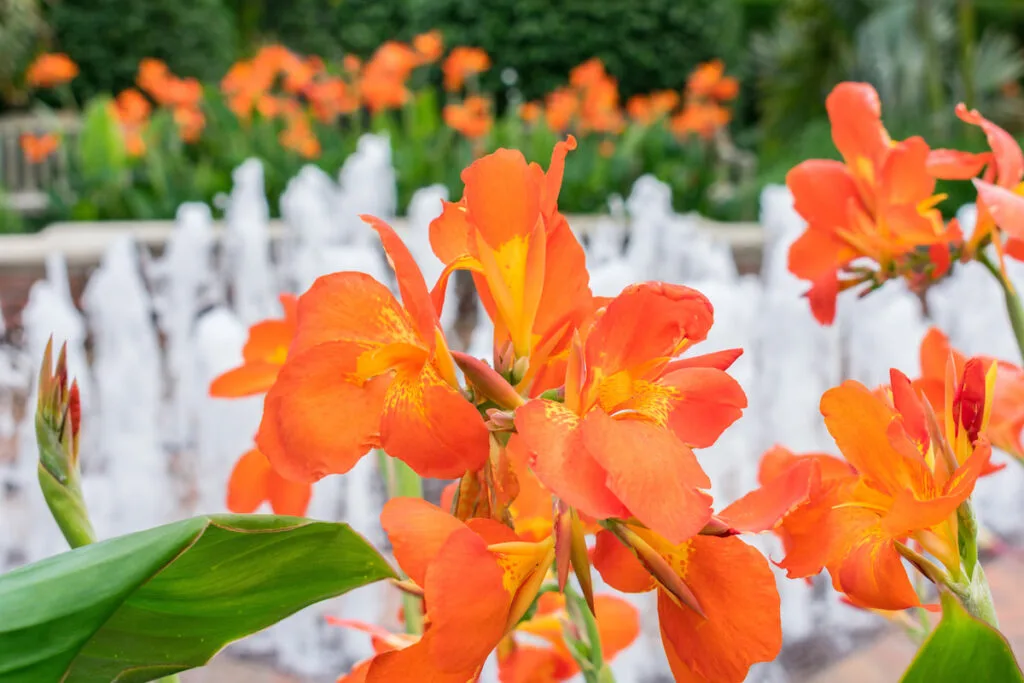
Cannas are frost-sensitive. Even the rhizomes in the soil are unlikely to survive the cold temperatures of winter.
Even within their hardiness zone, it is better to offer winter protection to your cannas.
How to Protect Your Cannas From Frost
- To protect cannas from frost, move them indoors. After the first frost date in your region, prune the foliage of your canna stems to around 4-6 inches. Then dig the canna bulbs out and store them inside. Do not store decaying or dead rhizomes; discard them.
While storing the rhizomes, ensure you remove most of the soil. Wrap each rhizome in a newspaper sheet, then place them in a box or crate that has no lid. After that, place the box/crate in a room with a temperature of at least 40°F.
Dahlias
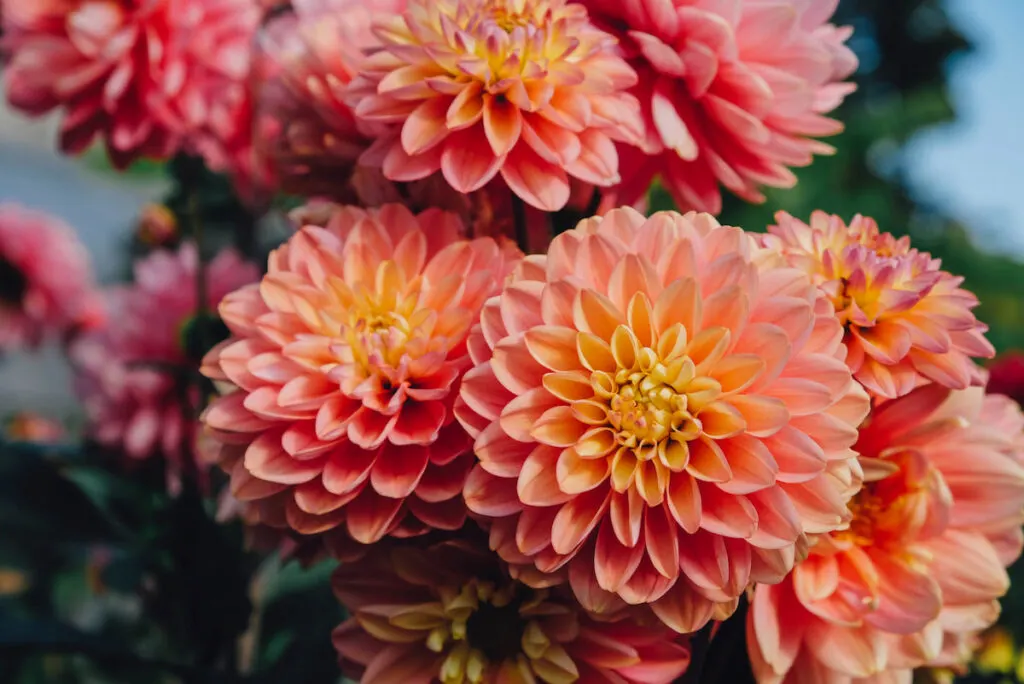
Dahlias thrive in warm weather. So, it is no surprise that their foliage, flowers, and stems are blackened when exposed to heavy frost. Luckily, their bulbs, which are protected by the soil, may survive and still be functional.
How to Protect Your Dahlias From Frost
- You can leave the dahlia bulbs in the soil with some mulch as cover. But before you do this, ensure your soil is well-drained and resistant to frost.
If it gets intensely cold in your region and the soil is heavy clay, do not leave the bulbs underground; they will not survive.
- Instead of leaving the bulbs in the soil, you may remove them and store them frost-free, ventilated shelter.
Elephant Ears
Elephant ears are only hardy in zones 9 to 11. So, as expected, they cannot survive frost. While every part of the plant aboveground will die off, the tubers may survive underground, especially when covered with mulch. But even the tubers sometimes freeze to death in the soil.
How to Protect Your Elephant Ears From Frost
- You can treat elephant ears like annuals, so you would not have to bother about frost.
- You can also remove the tubers from the soil and replant them when it is warm in spring.
- Planting the elephant ears in pots or containers and storing them in frost-free shelters can also help.
- If you intend to leave the tuber in the soil, cut back the dead foliage. Then shorten the stem to around 3-4 inches above the ground. Cover it all up with a dense layer of mulch.
Frost Sensitive Annuals
Petunias

These days, petunia cultivars can withstand warmer temperatures than usual. But most, if not all of them, are frost-sensitive. Recently, a cultivar called Petunia ‘Below Zero’ is reportedly hardy enough to tolerate temperatures as low as 14°F.
Generally, when the temperature goes below 40°F, petunias enter the danger zone. At this point, you should start considering options to shield the plant from the cold.
At 32°F, petunias would have been terribly damaged, and after that, it will not be long before they die.
How to Protect Your Petunias From Frost
- Move potted petunias indoors or to a sheltered area when frost comes. Ensure the area offers temperatures of at least 55°F.
- You can also cover your petunias with an old bedsheet. Most times, you will have to do this in the evening when the temperature falls. But if the temperature becomes moderate again in the morning, you may remove the covering. You may have to anchor the sheet if it gets windy.
Crabgrass
Crabgrass is an annual that dies after dropping seeds or experiencing frost. It thrives only in warm seasons, and you may never find it growing when there is frost.
Crabgrass seeds typically germinate over many weeks. But if by chance some seeds germinate during frost, the ensuing seedlings will die off quickly.
How to Protect Crabgrass From Frost
- Most people would rather not have crabgrass on their lawn or in their garden. But if you want to protect your crabgrass from frost, plant the seeds after the last spring frost date.
- You could also leave the seeds in the soil through winter; they will remain dormant until the soil is warm enough for germination.
Begonias
All types of begonias are frost-sensitive. Light freezing temperatures around 32°F may only affect the foliage and flowers. But as it gets colder, the tubers may be affected, and the plant will die.

How to Protect Begonias From Frost
- If fall and winter are mild in your region, you may not have to protect your begonias from frost.
- On the flip side, if you experience severe frost in your region, you should dig up the begonia tuber and store it indoors. Then when warm weather comes, replant it.
- You may also transfer your begonia plant into pots or containers and bring them indoors. In the same vein, if your begonia was potted from the start, bring it indoors.
Resources
- https://dengarden.com/gardening/Protecting-Plants-from-Spring-Frosts
- https://completelandscaping.com/plants-cant-handle-freezing-nights
- https://www.hortmag.com/weekly-tips/frost-tolerant-garden-vegetables
- https://www.weather.gov/source/zhu/ZHU_Training_Page/fog_stuff/Dew_Frost/Dew_Frost.htm
- http://www.tomatodirt.com/protecting-tomatoes.html
- https://homeguides.sfgate.com/frost-hurt-tomato-plants-fruit-55660.html
- https://homeguides.sfgate.com/can-okra-plants-cold-temperatures-68161.html
- https://www.quora.com/Do-okra-plants-resume-growing-in-spring-after-withering-following-a-winter-frost
- https://www.almanac.com/plant/okra
- https://agrilifeextension.tamu.edu/library/gardening/okra/
- http://corn.agronomy.wisc.edu/Management/L041.aspx
- https://graincrops.ca.uky.edu/content/frost-damage-young-corn
- https://www.goodhousekeeping.com/home/gardening/a20705742/how-to-grow-corn/
- https://farmfromhome.com/can-pumpkins-survive-a-frost/
- https://www.thespectrum.com/story/life/features/mesquite/2014/12/11/eggplant-growth-slows-cold-weathe
- https://homeguides.sfgate.com/temperature-bush-bean-plant-outside-56228.html
- https://www.growveg.com/plants/us-and-canada/how-to-grow-winter-field-beans/
- https://www.gardenersworld.com/plants/quick-ways-to-protect-plants-from-frost/
- https://greenupside.com/can-potato-plants-survive-frost-3-ways-to-protect-them/
- https://www.gardeningknowhow.com/edible/vegetables/sweet-potato/harvesting-sweet-potatoes.htm
- https://pss.uvm.edu/ppp/articles/sweetharv.html
- https://www.growveg.com/plants/us-and-canada/how-to-grow-amaranth-ornamental
- https://www.gardeningknowhow.com/ornamental/flowers/globe-amaranth/growing-globe-amaranth.htm
- https://www.growveg.com/plants/us-and-canada/how-to-grow-amaranth-grain/
- https://www.chron.com/life/gardening/article/Plant-by-plant-freeze-information-1766802.php
- https://www.gardeningknowhow.com/ornamental/shrubs/azalea/winter-protection-for-azaleas.htm
- https://www.rhododendron.org/protection.htm
- https://edis.ifas.ufl.edu
- https://homeguides.sfgate.com/care-lemon-tree-winter-55685.html
- https://homeguides.sfgate.com/can-lemon-trees-survive-after-frost-61222.html
- https://homeguides.sfgate.com/care-canna-lilies-winter-48405.html
- https://blackgold.bz/how-much-cold-can-petunias-handle/
- https://www.gardeningknowhow.com/ornamental/flowers/petunia/cold-tolerance-of-petunias.htm
- https://homeguides.sfgate.com/mango-trees-low-temperatures-can-handle-60789.html
- https://www.longfield-gardens.com/article/How-to-Overwinter-Dahlias#:
- https://www.gardenworld.co.uk/case-study/how-to-overwinter-dahlias/
- https://www.weed-pro.com/blog/bid/132241/will-the-early-spring-cause-a-major-crabgrass-outbreak
- https://lawncaresimplified.typepad.com/lawn_care_simplified_safe/2015/03/all-about-crabgrass.html
- https://www.gardeningknowhow.com/edible/fruits/banana/banana-plants-in-winter.htm
- https://www.hunker.com/13427102/how-to-care-for-giant-elephant-ears-in-winter
- https://www.gardenloversclub.com/ornamental/flowers/wax-begonia/overwintering-begonias/
- https://www.gardeningknowhow.com/ornamental/flowers/begonia/wintering-begonias-overwintering-a-begonia-in-cold-climates.htm
